The Camp Westfalia crew recently embarked on another Lake Superior Circle Tour: 1000 miles around the wild and rugged shores of the Greatest of the Great Lakes. Ride along!
 We drive north today toward the inland sea of Lake Superior. Happily cruising along in very light traffic under sunny skies, when suddenly an old El Camino in the right-hand lane veers left in front of us, to cross the median. I throw the wheel over hard to the left and lock up the Vanagon’s brakes, and we go into a four-wheel crabbing skid. We finally stop in the median cross-road, only five feet from his door.
We drive north today toward the inland sea of Lake Superior. Happily cruising along in very light traffic under sunny skies, when suddenly an old El Camino in the right-hand lane veers left in front of us, to cross the median. I throw the wheel over hard to the left and lock up the Vanagon’s brakes, and we go into a four-wheel crabbing skid. We finally stop in the median cross-road, only five feet from his door.
The eighty-year-old driver smiles and goes on his way, apparently oblivious to his deadly mistake. I scowl and go in search of a good stiff drink to settle my nerves …
From Duluth we continue north along Minnesota’s North Shore. Make it as far as Grand Portage, Minnesota, where we have a late-night slice of pizza in the casino cafe. We take a site in the adjacent RV park overlooking the marina, and settle in among the retirees squandering their 401k’s in the casino.
“Lorie’s Lounge” is soon open and (as previously mentioned) I finally enjoy my long-awaited adult beverage …
Sunrise on Lake Superior.
Our border crossing is uneventful, and we soon hit Thunder Bay, Ontario.
After a quick tour of the Sleeping Giant peninsula, we continue eastward along the Trans-Canada Highway, around the northernmost point of Lake Superior. Late afternoon finds us in Rossport, Ontario, where we stop at Rainbow Falls Provincial Park for lakeside camping on the Inland Sea …
We cruise the north shore today, rolling through rugged and rocky Canadian Shield country. Cold inland lakes glitter between granite mountains.
Exploring remote forest roads often leads to beautiful new discoveries. Sometimes not …
We finally camp at Pukaskwa National Park.
At Young’s General Store in Wawa, Ontario we are greeted by one of the city’s famous gargantuan geese. This particular bird was recently retired, and replaced by a new stainless steel model, which can be seen right from the highway.
Another fantastic campsite right on the beach at Agawa Bay Campground.
There are a few advantages to travelling in the off season: no crowds, no noise, no bugs (my god, the bugs!). In fact, not much of anything at all …
Pancake Bay Provincial Park. Legend has it when Lake Superior voyageurs camped here, they knew they were only one day away from fresh supplies in Sault Ste. Marie. So they used up the last of their flour and enjoyed a big ole batch of pancakes.
Mmmm, pancakes …
Having nearly completed our loop of the lake, I realize the Westy is entirely too clean. So, before turning south for home, we let her off the leash for a bit of backwoods romping in the dirt.
For an unabridged account of one of our Lake Superior Circle Tours, check out “A Superior State of Mind.”






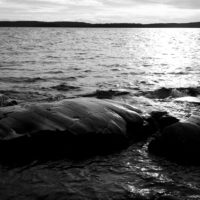








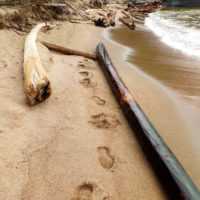
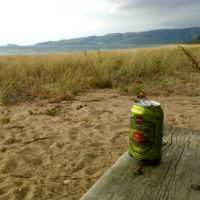














 In the spring of 1846 a body washed up on this section of Lake Superior shoreline. The man’s boots bore the initials, “D.H.”, and word spread like wildfire throughout the Keweenaw that the famed Douglass Houghton had finally been found.
In the spring of 1846 a body washed up on this section of Lake Superior shoreline. The man’s boots bore the initials, “D.H.”, and word spread like wildfire throughout the Keweenaw that the famed Douglass Houghton had finally been found. They labored long hours, and late into the season. On October 13, 1845, Houghton finished his work near here and, accompanied by an assistant, three French voyageurs, and his dog, Meme, set out for the mouth of the Eagle River to meet the rest of his survey crew. Superior’s mood soon turned foul with one of her notorious nor’easters, and she threw high winds and waves at the little party in their canoe. The voyageurs, who had been chosen for their famous skills on this inland sea, wondered aloud whether they should put ashore, but Houghton insisted they continue. The waves grew taller and steeper, threatening to swamp the men, and again the professional paddlers suggested they get out of the thick of things.
They labored long hours, and late into the season. On October 13, 1845, Houghton finished his work near here and, accompanied by an assistant, three French voyageurs, and his dog, Meme, set out for the mouth of the Eagle River to meet the rest of his survey crew. Superior’s mood soon turned foul with one of her notorious nor’easters, and she threw high winds and waves at the little party in their canoe. The voyageurs, who had been chosen for their famous skills on this inland sea, wondered aloud whether they should put ashore, but Houghton insisted they continue. The waves grew taller and steeper, threatening to swamp the men, and again the professional paddlers suggested they get out of the thick of things.
 Opened in 1847, the Delaware mine produced eight million pounds of copper over its three-decade life, and vast caverns have been excavated in the steeply slanted layers of stone here. When a vein of copper ore was found, the miners, working in two-man teams, spent five days a week hammering holes into the surrounding stone; one man held and turned the drill tool while the other hit it with a six-pound sledge hammer, driving an inch-and-half-diameter hole three feet deep. Saturday was “blasting day”, when the holes were carefully packed with black powder and ignited to blast loose the living rock; Sunday was a day of rest while the resultant dust settled in the mine shafts. On Monday morning, the rubble was sent up to the surface for sorting the waste rock from the richer ore, and the miners began drilling another inch-and-half-diameter hole.
Opened in 1847, the Delaware mine produced eight million pounds of copper over its three-decade life, and vast caverns have been excavated in the steeply slanted layers of stone here. When a vein of copper ore was found, the miners, working in two-man teams, spent five days a week hammering holes into the surrounding stone; one man held and turned the drill tool while the other hit it with a six-pound sledge hammer, driving an inch-and-half-diameter hole three feet deep. Saturday was “blasting day”, when the holes were carefully packed with black powder and ignited to blast loose the living rock; Sunday was a day of rest while the resultant dust settled in the mine shafts. On Monday morning, the rubble was sent up to the surface for sorting the waste rock from the richer ore, and the miners began drilling another inch-and-half-diameter hole.

 Paradoxically, this modest resting place for the Copper Country’s dead is a faithful reflection of life here on the shores of Superior. Like many of the Keweenaw’s residents past and present, this tidy graveyard is modest and simple, without such niceties as polished marble or delicate lawns, and it bears the signs of constant abuse by the harsh elements.
Paradoxically, this modest resting place for the Copper Country’s dead is a faithful reflection of life here on the shores of Superior. Like many of the Keweenaw’s residents past and present, this tidy graveyard is modest and simple, without such niceties as polished marble or delicate lawns, and it bears the signs of constant abuse by the harsh elements.

 Our small tour boat putters behind the point on which the lighthouse sits, and we disembark at the same landing used by the lighthouse keepers who lived and worked here for over fifty years. Preserved in the same condition as it was at the turn of the century, the Copper Harbor lighthouse is now maintained as part of Fort Wilkins SP, and a History Department staffer guides us around the grounds and the Cream City brick buildings. The original oil-fired light in the forty-two-foot tower has since been retired, and a modern light installed on a steel tower alongside the old one, but it’s still easy to imagine the solitary and often desolate life led by those lonely lightkeepers and their families. “… beyond the most distant wilderness and remote as the moon,” statesman Patrick Henry told Congress after early mining attempts were abandoned in 1771.
Our small tour boat putters behind the point on which the lighthouse sits, and we disembark at the same landing used by the lighthouse keepers who lived and worked here for over fifty years. Preserved in the same condition as it was at the turn of the century, the Copper Harbor lighthouse is now maintained as part of Fort Wilkins SP, and a History Department staffer guides us around the grounds and the Cream City brick buildings. The original oil-fired light in the forty-two-foot tower has since been retired, and a modern light installed on a steel tower alongside the old one, but it’s still easy to imagine the solitary and often desolate life led by those lonely lightkeepers and their families. “… beyond the most distant wilderness and remote as the moon,” statesman Patrick Henry told Congress after early mining attempts were abandoned in 1771.


 The ancient peoples who first mined copper here on the Keweenaw eventually ceased working and disappeared entirely, and their culture, their methods of early metalworking, their knowledge, were all lost to the mists of time. Among the whites who later moved into this region, stories and legends of the red metal persisted, fueled by the occasional discovery of five-ton boulders of pure copper. But it wasn’t until French fur-trapping voyageurs seeking a safe harbor for their canoes spied La Roche Verte—The Green Rock—that serious modern-age mining began. The vein of nearly pure copper silicate—which can still be seen today—rising from the dark waters of Superior shot up the rocky shoreline and continued into the green forests beyond. With the building of the Soo Locks in 1855, large commercial vessels could now ply the upper lake, making feasible the large-scale extraction of copper; visions of immense wealth danced in the eyes of speculators, and a tent city of eager prospectors sprang up on Porter Island at the mouth of Copper Harbor; the rush was on.
The ancient peoples who first mined copper here on the Keweenaw eventually ceased working and disappeared entirely, and their culture, their methods of early metalworking, their knowledge, were all lost to the mists of time. Among the whites who later moved into this region, stories and legends of the red metal persisted, fueled by the occasional discovery of five-ton boulders of pure copper. But it wasn’t until French fur-trapping voyageurs seeking a safe harbor for their canoes spied La Roche Verte—The Green Rock—that serious modern-age mining began. The vein of nearly pure copper silicate—which can still be seen today—rising from the dark waters of Superior shot up the rocky shoreline and continued into the green forests beyond. With the building of the Soo Locks in 1855, large commercial vessels could now ply the upper lake, making feasible the large-scale extraction of copper; visions of immense wealth danced in the eyes of speculators, and a tent city of eager prospectors sprang up on Porter Island at the mouth of Copper Harbor; the rush was on. To protect the the miners and other workers from the hordes of ravaging Indians, a military fort was commissioned. As it turned out, the natives were uninterested in the copper, and friendly besides. So the soldiers spent more time keeping the peace between the hard-drinking miners, who grew especially restless when they finally realized what the natives already knew: the copper was really hard to dig up.
To protect the the miners and other workers from the hordes of ravaging Indians, a military fort was commissioned. As it turned out, the natives were uninterested in the copper, and friendly besides. So the soldiers spent more time keeping the peace between the hard-drinking miners, who grew especially restless when they finally realized what the natives already knew: the copper was really hard to dig up. Propped against the base of the sign declaring the various trails which depart from here, there is a handmade memorial of sorts, poking above the weeds. It is an eight-by-ten picture frame, and beneath the glass—sun-faded, water-wrinkled, and lightly speckled with mildew—a hand-scrawled sheet of paper reads, “DANGEROUS CLIFFS! While walking our dog here on May 19th he ran off and fell over an UNMARKED CLIFF. He broke his neck and died! Please BEWARE, and don’t let this happen to YOUR beloved friend!” Near the bottom, the epitaph concludes with, “In memoriam Poochie, 2005”. Or Poppins, or Diggity, or Mr. Snuffles, or whatever the name was.
Propped against the base of the sign declaring the various trails which depart from here, there is a handmade memorial of sorts, poking above the weeds. It is an eight-by-ten picture frame, and beneath the glass—sun-faded, water-wrinkled, and lightly speckled with mildew—a hand-scrawled sheet of paper reads, “DANGEROUS CLIFFS! While walking our dog here on May 19th he ran off and fell over an UNMARKED CLIFF. He broke his neck and died! Please BEWARE, and don’t let this happen to YOUR beloved friend!” Near the bottom, the epitaph concludes with, “In memoriam Poochie, 2005”. Or Poppins, or Diggity, or Mr. Snuffles, or whatever the name was. The river has carved a 300-foot-deep canyon in the region’s volcanic bedrock here, and it rushes through a steep and narrow chute before crashing spectacularly over a twenty-foot ledge. We sit at the base of the falls, taking in its impressive and eternal power, and enjoy a trail snack while letting the spray from the falls drift over and cool us. Finally refreshed, we climb the steep gorge trail to the Westy and return to the head of the harbor, where we catch US 41 at Baraga and continue north onto the Keweenaw Peninsula.
The river has carved a 300-foot-deep canyon in the region’s volcanic bedrock here, and it rushes through a steep and narrow chute before crashing spectacularly over a twenty-foot ledge. We sit at the base of the falls, taking in its impressive and eternal power, and enjoy a trail snack while letting the spray from the falls drift over and cool us. Finally refreshed, we climb the steep gorge trail to the Westy and return to the head of the harbor, where we catch US 41 at Baraga and continue north onto the Keweenaw Peninsula. With its long natural and human histories, there is much to see and do here, so we stop in to the Chamber of Commerce visitor center in Houghton for some maps and other information. It’s already past the end of the summer season, the autumn leaves are a few weeks away from peak color, and a chilling wind blows in through the shipping canal. It’s pretty slow in the welcome center; it’s just us and the friendly woman behind the desk, who seems either worn out by the summer tourists or resting up for the upcoming fall-color rush. We select some maps and brochures, and indulge her invitation to sign the guest book; it’s nearly closing time and we are the third visitors on today’s page.
With its long natural and human histories, there is much to see and do here, so we stop in to the Chamber of Commerce visitor center in Houghton for some maps and other information. It’s already past the end of the summer season, the autumn leaves are a few weeks away from peak color, and a chilling wind blows in through the shipping canal. It’s pretty slow in the welcome center; it’s just us and the friendly woman behind the desk, who seems either worn out by the summer tourists or resting up for the upcoming fall-color rush. We select some maps and brochures, and indulge her invitation to sign the guest book; it’s nearly closing time and we are the third visitors on today’s page. It has begun to rain again, so we forego a hike in Pictured Rocks National Lakeshore. We backpacked here several years ago, but the best views of the painted cliffs are from the waters of Lake Superior, either from a tour boat or your own sea kayak.
It has begun to rain again, so we forego a hike in Pictured Rocks National Lakeshore. We backpacked here several years ago, but the best views of the painted cliffs are from the waters of Lake Superior, either from a tour boat or your own sea kayak.
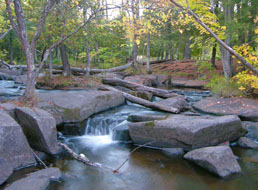 When we bought the van a year before, the previous owners had recently experienced a highway blowout and replaced the right-rear tire. Now the opposite tire is trashed. Subsequent online research will later confirm that the German frat boys from whom we bought the van had made the common mistake of installing everyday passenger-car tires on the Westy, when light-truck or Load Range C or D are required. With the heavy rear-engine configuration of the Vanagon, and the added weight of the Camper package, conventional car tires will squirm like cheap sneakers on an elephant, and dangerously begin unravelling within several thousand miles. Upon returning home I will install the correct tires, which, besides vastly improving the handling, also offer superior wear.
When we bought the van a year before, the previous owners had recently experienced a highway blowout and replaced the right-rear tire. Now the opposite tire is trashed. Subsequent online research will later confirm that the German frat boys from whom we bought the van had made the common mistake of installing everyday passenger-car tires on the Westy, when light-truck or Load Range C or D are required. With the heavy rear-engine configuration of the Vanagon, and the added weight of the Camper package, conventional car tires will squirm like cheap sneakers on an elephant, and dangerously begin unravelling within several thousand miles. Upon returning home I will install the correct tires, which, besides vastly improving the handling, also offer superior wear. At the opposite end of the bridge, we stop for US Customs. Though we have no contraband, we cross our fingers and hope the Customs officers will not look unkindly upon our ‘hippie bus’ and see fit to give it a thorough inspection. To search through every nook and cranny, some of which even I have yet to discover, would undoubtedly take hours. But with one look at our undilated pupils and bland Midwestern faces, they wave us through after only a few pointed questions, and we motor south then west into Michigan’s Upper Peninsula.
At the opposite end of the bridge, we stop for US Customs. Though we have no contraband, we cross our fingers and hope the Customs officers will not look unkindly upon our ‘hippie bus’ and see fit to give it a thorough inspection. To search through every nook and cranny, some of which even I have yet to discover, would undoubtedly take hours. But with one look at our undilated pupils and bland Midwestern faces, they wave us through after only a few pointed questions, and we motor south then west into Michigan’s Upper Peninsula.
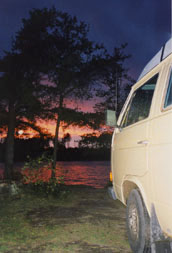 Some blame defective cargo hatch covers, which allowed the huge waves which broke over the deck that night to flood the Fitzgerald’s holds. Others point to faulty or damaged ballast-tank vents, which prevented pumping sufficient to keep her afloat. Still others hint that she may have earlier struck a shallow shoal off Michipicoten Island, near Lake Superior Provincial Park, causing an unseen and fatal breach. Even after all these years and numerous investigations regarding the exact cause of the Fitzgerald’s tragic and deadly loss, answers are not forthcoming, and details remain as murky as the dark depths of Superior.
Some blame defective cargo hatch covers, which allowed the huge waves which broke over the deck that night to flood the Fitzgerald’s holds. Others point to faulty or damaged ballast-tank vents, which prevented pumping sufficient to keep her afloat. Still others hint that she may have earlier struck a shallow shoal off Michipicoten Island, near Lake Superior Provincial Park, causing an unseen and fatal breach. Even after all these years and numerous investigations regarding the exact cause of the Fitzgerald’s tragic and deadly loss, answers are not forthcoming, and details remain as murky as the dark depths of Superior. There is an even earlier, passenger-service train each day, which mainly hauls local backcountry residents and those venturing into the woods for hiking, fishing, and hunting. On a couple occasions several years ago, my family loaded camping gear and two canoes onto the train’s baggage cars and rode up to Mile Marker 92, where a spectacular steel trestle spans the Montreal River. Here we yanked the signal cord running through our car and the train stopped while we quickly off-loaded our stuff by the side of the tracks. As we lugged the gear down to the water, the train tooted its horn and continued on its way northward, not caring whether it ever saw us again. We paddled fifteen miles or so up the wide flowage and camped and fished on a remote backwoods island. We saw not another soul until we returned to the tracks a week later and flagged down the daily train for a ride back to Sault Ste. Marie.
There is an even earlier, passenger-service train each day, which mainly hauls local backcountry residents and those venturing into the woods for hiking, fishing, and hunting. On a couple occasions several years ago, my family loaded camping gear and two canoes onto the train’s baggage cars and rode up to Mile Marker 92, where a spectacular steel trestle spans the Montreal River. Here we yanked the signal cord running through our car and the train stopped while we quickly off-loaded our stuff by the side of the tracks. As we lugged the gear down to the water, the train tooted its horn and continued on its way northward, not caring whether it ever saw us again. We paddled fifteen miles or so up the wide flowage and camped and fished on a remote backwoods island. We saw not another soul until we returned to the tracks a week later and flagged down the daily train for a ride back to Sault Ste. Marie. This passenger-service train is often filled with local backwoods residents who live year-round in scattered cabins and shacks, shaggy and aromatic Yukon Cornelius types, perhaps on their once-a-month sojourn into the city for more cornmeal, gunpowder, hamhocks, and guitar strings. Heck, maybe even their monthly hot bubble-bath …
This passenger-service train is often filled with local backwoods residents who live year-round in scattered cabins and shacks, shaggy and aromatic Yukon Cornelius types, perhaps on their once-a-month sojourn into the city for more cornmeal, gunpowder, hamhocks, and guitar strings. Heck, maybe even their monthly hot bubble-bath …
 On the long, final run toward Sault Ste. Marie, I perceive a faint vibration emanating from the left-rear wheel. In retrospect, I seem to vaguely recall first hearing the noise a couple days ago, and the gentle thrumming has slowly grown since then. Hoping it does not indicate the imminent failure of a CV joint, I determinedly put my foot down and continue east and southward.
On the long, final run toward Sault Ste. Marie, I perceive a faint vibration emanating from the left-rear wheel. In retrospect, I seem to vaguely recall first hearing the noise a couple days ago, and the gentle thrumming has slowly grown since then. Hoping it does not indicate the imminent failure of a CV joint, I determinedly put my foot down and continue east and southward. It is only a short drive to where the Kaministiquia enters Lake Superior. In 1803 the North West Company built Fort William at the river’s mouth, and for many years the site served as the Company’s key shipment center on Lake Superior. Now reconstructed and opened as a living history program, the Fort depicts the days of the booming fur trade, circa 1803-1821. Heavily-laden voyageur canoes arrived here from Montreal, bearing manufactured trading goods for the Fort. Meanwhile, the American and Canadian interiors produced tons of furs—beaver, fox, badger, mink, even raccoon—carried down in small river canoes. These sixteen-foot Indian craft were well-suited to the narrow streams, dangerous rapids, and long portages common in the remote country.
It is only a short drive to where the Kaministiquia enters Lake Superior. In 1803 the North West Company built Fort William at the river’s mouth, and for many years the site served as the Company’s key shipment center on Lake Superior. Now reconstructed and opened as a living history program, the Fort depicts the days of the booming fur trade, circa 1803-1821. Heavily-laden voyageur canoes arrived here from Montreal, bearing manufactured trading goods for the Fort. Meanwhile, the American and Canadian interiors produced tons of furs—beaver, fox, badger, mink, even raccoon—carried down in small river canoes. These sixteen-foot Indian craft were well-suited to the narrow streams, dangerous rapids, and long portages common in the remote country.
 After a sullen lunch of Voyageur’s Stew (hefty chunks of moose flesh, with a few token peas, carrots, and diced potatoes) eaten in the rustic dining hall, we motor through the gloomy industrial city of Thunder Bay, a grey drizzle constantly spraying the Vanagon’s windshield. Swinging onto the Trans-Canada Highway, we follow the rugged Superior shoreline eastward through Nipigon, Terrace Bay, and White River.
After a sullen lunch of Voyageur’s Stew (hefty chunks of moose flesh, with a few token peas, carrots, and diced potatoes) eaten in the rustic dining hall, we motor through the gloomy industrial city of Thunder Bay, a grey drizzle constantly spraying the Vanagon’s windshield. Swinging onto the Trans-Canada Highway, we follow the rugged Superior shoreline eastward through Nipigon, Terrace Bay, and White River.








